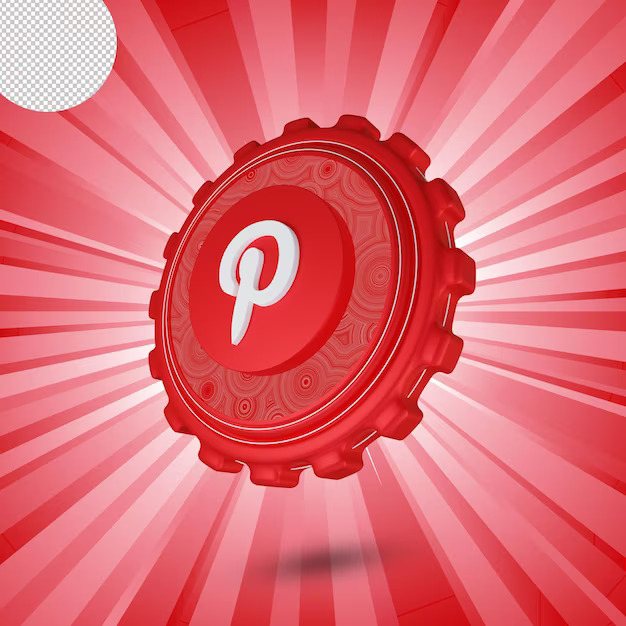Pinterest SEO has emerged as a prominent strategy for visual discovery, inspiration, and creativity.
With its vast user base and unique search engine capabilities, Pinterest offers an incredible opportunity for businesses and content creators to drive high traffic to their websites or blogs.
By understanding how this algorithm works and implementing effective SEO techniques, you can significantly increase your visibility, attract the right audience, and drive quality traffic to your online presence.
What is Pinterest SEO Strategy

Pinterest is not just a platform for saving and organizing inspiring images; it’s also a powerful search engine that can significantly boost your website’s traffic and visibility.
To maximize the benefits of Pinterest for your business, implementing a solid SEO strategy is crucial.
Here’s a step-by-step guide to help you develop an effective Pinterest SEO strategy:
Understand Pinterest’s Search Algorithm

To succeed on Pinterest, you need to understand how its search algorithm works.
Pinterest focuses on delivering relevant and personalized results to users.
It considers factors such as keyword usage, pin engagement, domain quality, and pinner quality to determine search rankings.
Perform Keyword Research

Keyword research is the foundation of any SEO strategy, and the same applies to Pinterest.
Identify keywords that are relevant to your niche, target audience, and the content you want to promote.
Tools like Pinterest Trends, Google Trends, and keyword research tools can help you discover popular and trending keywords on Pinterest.
Optimize Your Pinterest Profile Start

By optimizing your Pinterest profile to enhance your visibility.
Use a clear and descriptive profile name, include relevant keywords in your profile bio, and add a link to your website.
Ensure your profile is complete and reflects your brand’s identity.
Create SEO-Friendly Boards

Organize your Pinterest boards thematically, using keyword-rich board names and descriptions.
Focus on topics that align with your niche and target audience’s interests.
Including relevant keywords will help Pinterest understand your content and improve your chances of appearing in relevant search results.
Craft Compelling Pin Descriptions

When creating pins, write detailed and keyword-rich descriptions.
Clearly explain what the pin is about, and include relevant keywords naturally.
Use a conversational tone and include a compelling call-to-action to encourage users to engage with your pin and visit your website.
Pin Consistently

Pinterest favors active users, so make it a habit to pin regularly and consistently.
Aim for a mix of your own content and relevant content from others.
Schedule pins using tools like Tailwind to maintain a consistent presence without spending excessive time manually pinning.
Engage with the Pinterest Community

Build connections and engage with the Pinterest community by repinning, liking, and commenting on others’ content.
Participate in group boards and collaborate with influencers in your niche.
This not only increases your visibility but also helps establish relationships that can drive traffic to your website.
Monitor and Analyze Performance

Regularly analyze your Pinterest analytics to gain insights into your pin performance.
Identify which pins are driving the most traffic, engagement, and conversions.
Use this data to refine your strategy, create more of what works, and make improvements where needed.
Cross-Promote on Other Channels

Leverage your existing online presence by cross-promoting your Pinterest account and pins on other social media platforms, your website, and email newsletters.
This helps expand your reach and attract more traffic from different sources.
By implementing these Pinterest SEO strategies, you can increase your visibility, drive high-quality traffic to your website, and ultimately achieve success.
12 Pinterest SEO Tips
1.Research and Strategically Use Keywords

Researching and strategically using keywords is a crucial aspect of optimizing your presence on Pinterest and improving your visibility in search results.
By understanding the search behavior of your target audience and strategically incorporating relevant keywords, you can increase the chances of your pins being discovered by users interested in your content.
Start by gaining a deep understanding of your target audience.
Identify their interests, preferences, and the keywords they are likely to search for when looking for content similar to yours.
Put yourself in their shoes and think about the terms and phrases they would use to find relevant pins.
Remember that while keywords are essential, they should always be used in a way that enhances the user experience.
Your pins and boards should provide valuable and relevant content that aligns with the keywords you are targeting.
By conducting thorough keyword research and strategically incorporating keywords, you can increase the discoverability of your content on Pinterest.
Additionally, attracting a larger and more relevant audience to your website or blog.
2.Create Eye-Catching Pins

Creating eye-catching pins is a critical aspect of optimizing your Pinterest strategy.
With millions of pins competing for attention, it’s crucial to design visually appealing pins that stand out and entice users to click and engage.
Here are some key elements to consider when creating eye-catching pins:
High-Quality Images
Start with high-quality, visually striking images.
Use high-resolution photos or create compelling graphics that are visually appealing and aligned with your brand or content theme.
Crisp and clear images will make your pins more appealing and encourage users to explore further.
Engaging Graphics and Text Overlays
Enhance your pins with engaging graphics and text overlays.
Add compelling headlines, quotes, or descriptions that grab attention and convey the value or message of your pin.
Use legible fonts, contrasting colors, and captivating design elements to make your text overlays visually appealing and easy to read.
By focusing on high-quality images, engaging graphics and text overlays, consistent branding, descriptive titles, vertical pin dimensions, design consistency, you can create eye-catching pins that captivate users and drive higher engagement and click-through rates.
Remember, the goal is to create visually appealing pins that entice users to explore your content further and ultimately drive traffic to your website or blog.
3.Optimize Pin Descriptions

Optimizing pin descriptions is a crucial step in improving the visibility and searchability of your pins on Pinterest.
Well-crafted and keyword-rich descriptions can significantly increase the chances of your pins appearing in relevant search results and capturing the attention of users.
Here are some tips to help you optimize your pin descriptions effectively:
Be Detailed and Informative
When writing pin descriptions, provide detailed information about the content of the pin.
Clearly explain what the pin is about and what users can expect to find when they click on it.
Use descriptive language to give users a clear understanding of the value or benefits your pin offers.
Include a Call-to-Action
Encourage users to take action by including a clear call-to-action (CTA) in your pin descriptions.
For example, you can prompt users to click on the pin to learn more, visit your website, or save the pin for later.
A compelling CTA can help drive engagement and increase click-through rates.
By following these optimization tips and crafting well-written, detailed, and keyword-rich pin descriptions, you can increase the visibility of your pins, attract the right audience, and drive more engagement and click-throughs.
Remember to review and update your pin descriptions periodically to ensure they remain relevant and aligned with your content strategy.
4.Organize Boards Thematically

Organizing your boards thematically on Pinterest is an essential step in optimizing your profile and making it easier for users to discover and navigate your content.
Thematic board organization allows users to find relevant pins more efficiently and encourages them to explore more of your content.
Here are some tips to help you organize your boards thematically:
Identify Key Themes
Start by identifying the key themes or topics that align with your content. Consider the different categories or areas of interest that your pins cover.
For example, if you have a food blog, you may have thematic boards like “Breakfast Recipes,” “Healthy Snacks,” “Dessert Delights,” etc.
Use Clear and Descriptive Board Titles
Use clear and descriptive board titles that accurately represent the content within each board.
Avoid vague or ambiguous titles that may not provide enough context.
For example, instead of a board titled “Food,” opt for a more specific title like “Easy Dinner Recipes” or “Vegetarian Delights.”
By organizing your boards thematically, you make it easier for users to navigate your profile and find the content they are interested in.
This improves the overall user experience and encourages them to engage with and follow your boards.
Take the time to plan your board structure thoughtfully and update it regularly to keep your profile fresh and appealing.
5.Enable Rich Pins

Enabling rich pins on Pinterest is a valuable strategy to enhance the appearance and functionality of your pins.
Rich pins provide additional information, such as article headlines, product details, recipe ingredients, or app install buttons, directly within the pin itself.
This added context makes your pins more engaging, informative, and attractive to users.
Here’s how you can enable rich pins for your Pinterest account:
Prepare Your Website
Ensure that your website or blog is set up to support rich pins.
You’ll need to add specific metadata to your site’s HTML to enable this feature.
Depending on the type of rich pin you want to use (article, product, recipe, etc.), you’ll need to include the appropriate metadata tags on the relevant pages of your website.
Validate Your Website
Validate your website’s metadata using Pinterest’s Rich Pins Validator tool.
Enter the URL of a page that you want to enable for rich pins, and the tool will check if the necessary metadata is present.
If there are any errors or missing tags, you’ll need to adjust your website’s HTML to include the required information.
By enabling rich pins, you provide users with valuable information directly within your pins, increasing their appeal and functionality.
Whether you’re sharing articles, products, recipes, or other content types, rich pins can help you stand out and provide a better user experience.
Follow the steps outlined above to enable rich pins for your Pinterest account and unlock the benefits they offer.
6.Utilize Alt Text

Utilizing alt text, also known as alternative text, is an important practice to optimize your pins on Pinterest.
Alt text provides a text description of your images, making them accessible to individuals who are visually impaired and aiding search engines in understanding your content.
Here are some tips to effectively utilize alt text on Pinterest:
Be Descriptive
When writing alt text, be descriptive and provide a concise summary of the image.
Describe the visual elements, context, and any relevant details that would help someone understand what the image is about.
Keep it Concise
While it’s important to be descriptive, keep your alt text concise.
Aim for a length of around 125 characters or less, as longer alt text may be truncated by screen readers or search engine results.
By utilizing alt text effectively, you improve the accessibility of your pins and provide search engines with valuable information about your content.
This can lead to improved search engine rankings and make your pins more discoverable to a wider audience.
Remember to keep your alt text descriptive, concise, and focused on providing a meaningful representation of your images.
7.Pin Regularly

Pinning regularly is a crucial strategy to maintain an active presence on Pinterest and keep your audience engaged.
Consistent pinning not only increases your visibility but also enhances your chances of driving more traffic to your website or blog.
Here are some tips to help you establish a regular pinning schedule:
Pin at Optimal Times
Research the optimal times to pin on Pinterest, as it can vary depending on your target audience and niche.
Generally, pinning during evenings and weekends tends to generate higher engagement.
Use Pinterest analytics to track the performance of your pins and identify the times when your audience is most active.
Stay Fresh and Relevant
Keep up with current trends and seasonal topics to ensure your pins remain fresh and relevant.
Create boards or pin content related to trending topics, holidays, or seasonal events. This demonstrates that your profile is active and up to date.
By pinning regularly, you increase your visibility, engage your audience, and drive more traffic to your website or blog.
Establish a consistent pinning schedule, utilize scheduling tools, diversify your content, engage with others, and stay up to date with trends.
With a well-executed pinning strategy, you can effectively leverage the power of Pinterest to achieve high-traffic success.
8.Collaborate with Others

Collaborating with others on Pinterest is a fantastic way to expand your reach, tap into new audiences, and build relationships within the platform’s community.
By collaborating, you can share and promote each other’s content, engage with a broader audience, and benefit from the collective expertise and following of your collaborators.
Here are some effective strategies for collaborating with others on Pinterest:
Identify Potential Collaborators
Look for Pinterest users or businesses within your niche or complementary industries that align with your brand and target audience.
Seek out individuals or brands with a similar or slightly larger following to maximize the potential reach of your collaboration.
Reach Out and Establish Relationships
Initiate contact with potential collaborators through direct messages, email, or by commenting on their pins.
Introduce yourself, express your admiration for their work, and propose a collaboration idea.
Be genuine, specific, and highlight the potential mutual benefits of collaborating.
Remember that collaboration is a two-way street.
Offer support and value to your collaborators by promoting their content and engaging with their audience.
Stay open to creative ideas and mutually beneficial opportunities.
By collaborating with others on Pinterest, you can leverage the power of community, broaden your reach, and achieve high-traffic success.
9.Optimize Board Covers

Optimizing your board covers on Pinterest is an effective way to enhance the visual appeal of your profile and make it more inviting to users.
Board covers serve as the first impression of your boards, and a well-designed cover can attract more clicks and engagement.
Here are some tips to optimize your board covers on Pinterest:
Consistent Style and Theme
Maintain a consistent style and theme across your board covers to create a cohesive and visually appealing profile.
Use similar colors, fonts, or graphic elements that reflect your brand or the content of your boards.
Consistency helps establish a strong visual identity and makes your profile more recognizable.
Highlight Key Elements
Consider adding text overlays or icons to your board covers to highlight the main topic or focus of the board.
This helps users quickly understand the purpose of each board and makes it easier for them to find the content they’re interested in.
In other words, by optimizing your board covers, you create a visually appealing profile that attracts users and encourages them to explore your content.
Use high-quality images, maintain a consistent style, create custom covers, and strategically arrange your boards.
In conclusion, eegularly update and analyze the performance of your covers to ensure they effectively represent your brand and engage your audience on Pinterest.
10.Share on Other Platforms

In other words, sharing your Pinterest content on other platforms is a smart strategy to increase its visibility, attract a wider audience, and drive traffic back to your Pinterest profile and website.
By cross-promoting your pins on various platforms, you can leverage the existing following and engagement on those platforms to boost your Pinterest presence.
Here are some tips to effectively share your Pinterest content on other platforms:
Share on Social Media
Promote your pins on popular social media platforms such as Facebook, Twitter, Instagram, and LinkedIn.
Craft engaging captions that entice your followers to click and explore the pin.
In conclusion, include a direct link to your Pinterest profile or specific pin to make it easy for your audience to access the content.
Utilize Pinterest Widgets
Pinterest provides various widgets that you can embed on your website or blog.
These widgets showcase your Pinterest profile, boards, or individual pins, allowing visitors to engage with your Pinterest content directly from your site.
In addition, remember to adapt your sharing strategy for each platform, considering the best practices and audience preferences of those platforms.
In conclusion, be consistent in sharing your Pinterest content across various channels to maximize its exposure and drive more traffic back to your Pinterest profile and website.
Conclusion
In conclusion, mastering Pinterest SEO is a powerful tool for driving high traffic and achieving success in the competitive digital landscape.
In addition, by implementing a well-rounded Pinterest SEO strategy, you can enhance your visibility, attract your target audience, and ultimately drive more traffic to your website or blog.
Focus on creating visually stunning pins that capture attention and compel users to engage with your content.
Similarly, with a strong Pinterest SEO strategy in place, you can harness the potential of this dynamic platform to drive high-quality traffic, increase brand visibility, and achieve your goals.
Embrace the visual allure of Pinterest and unlock the power of high-traffic success.
If you liked this article, consider reading another about Behavioral Marketing here.
